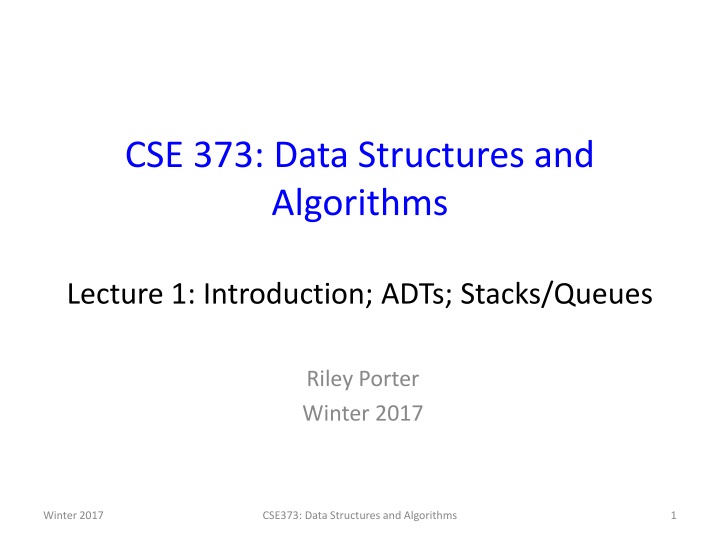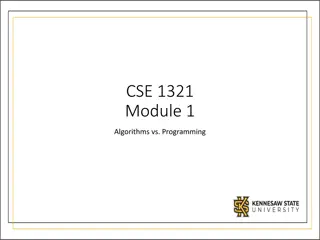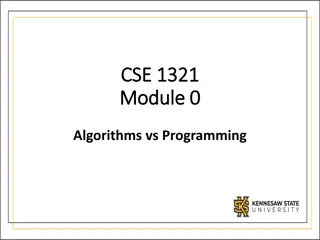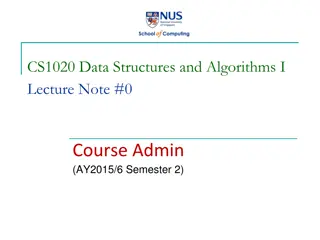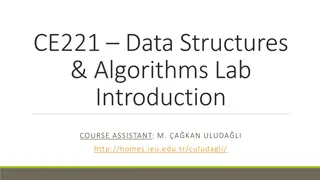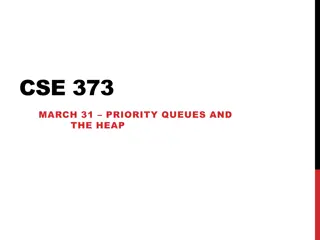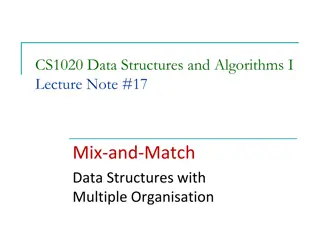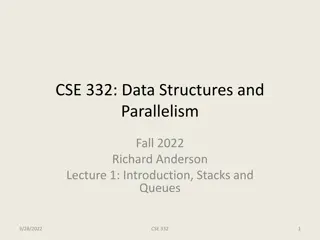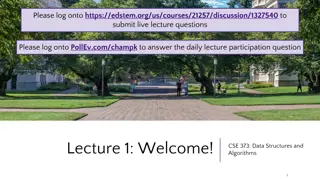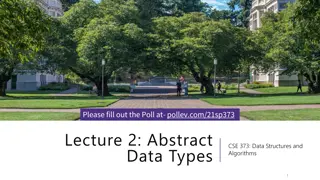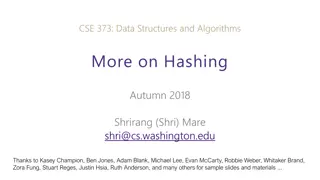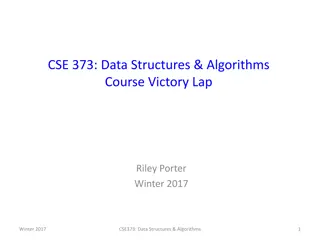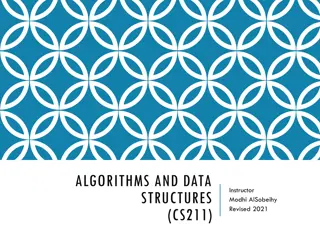Introduction to CSE 373: Data Structures and Algorithms
Dive into the fundamentals of data structures and algorithms with CSE 373. Learn about abstract data types, stacks, queues, and more. Get insights into course mechanics, staff details, to-do list, and communication channels for the winter 2017 session.
Download Presentation

Please find below an Image/Link to download the presentation.
The content on the website is provided AS IS for your information and personal use only. It may not be sold, licensed, or shared on other websites without obtaining consent from the author.If you encounter any issues during the download, it is possible that the publisher has removed the file from their server.
You are allowed to download the files provided on this website for personal or commercial use, subject to the condition that they are used lawfully. All files are the property of their respective owners.
The content on the website is provided AS IS for your information and personal use only. It may not be sold, licensed, or shared on other websites without obtaining consent from the author.
E N D
Presentation Transcript
CSE 373: Data Structures and Algorithms Lecture 1: Introduction; ADTs; Stacks/Queues Riley Porter Winter 2017 Winter 2017 CSE373: Data Structures and Algorithms 1
Welcome! This course is about fundamental data structures and algorithms for organizing and processing information Classic data structures / algorithms and how to analyze rigorously their efficiency and when to use them Queues, dictionaries, graphs, sorting, etc. Today in class: Introductions and course mechanics What this course is about Start abstract data types (ADTs), stacks, and queues Winter 2017 CSE373: Data Structures and Algorithms 2
Overloading Go to : Overload Form link: https://catalyst.uw.edu/webq/survey/cseadv/321439 or http://tinyurl.com/hz9sxzd Code Word: Given in Lecture Do this by 1 hour after this lecture! Winter 2017 CSE373: Data Structures and Algorithms 3
Course staff Instructor: Riley Porter, CSE 450, rileymp2@cs.washington.edu TA: Zelina Chen : zelinac@cs.washington.edu TA: Paul Curry : paulmc@cs.washington.edu TA: Josh Curtis : curtijd@cs.washington.edu TA: Chloe Lathe : lathec@cs.washington.edu TA: Trung Ly : trungly@cs.washington.edu TA: Matthew Rockett : rockettm@cs.washington.edu TA: Kyle Thayer : kthayer@cs.washington.edu TA: Raquel Van Hofwegen : raqvh@cs.washington.edu TA: Pascale Wallace Patterson : pattersp@cs.washington.edu TA: Rebecca Yuen : rebyuen@cs.washington.edu TA: Hunter Zahn : hzahn93@cs.washington.edu Winter 2017 CSE373: Data Structures and Algorithms 4
Concise to-do list In next 24-48 hours: Take homework 0 (worth 0 points) as Catalyst quiz Read/skim Chapters 1 and 3 of Weiss book Relevant to Homework 1, due next week Set up your Java environment for Homework 1 Check out the Course Website and read all the course policies: https://courses.cs.washington.edu/courses/cse373/ 17wi Winter 2017 CSE373: Data Structures and Algorithms 5
Communication Course email list: cse373_wi17@u.washington.edu Students and staff already subscribed Fairly low traffic Course staff: cse373-staff@cs.washington.edu plus individual emails Discussion board For appropriate discussions; TAs will monitor Encouraged, but won t use for important announcements Anonymous feedback link For good and bad: if you don t tell me, I don t know Winter 2017 CSE373: Data Structures and Algorithms 6
Course meetings Lectures Materials posted on the website Ask questions, focus on key ideas Not recorded Sections on Thursdays Programming practice, homework prep Math review and example exam problems Would be a really bad idea not to go, won t always post all materials on the website Winter 2017 CSE373: Data Structures and Algorithms 7
Office Hours Riley: Tuesday 1:30 3:20pm in CSE 450 Use them: please visit me... I have candy... Ideally not just for homework questions (but that s OK too) TA s: To be determined will be posted on the website today/tomorrow Winter 2017 CSE373: Data Structures and Algorithms 8
Course materials All lecture and section materials will be posted But they are visual aids, not always a complete description! If you have to miss, find out what you missed Textbook: Weiss 3rd Edition in Java Good read, but only responsible for lecture/hw topics 3rd edition improves on 2nd, but we ll support the 2nd A good Java reference of your choosing Google is only so helpful Winter 2017 CSE373: Data Structures and Algorithms 9
Computing College of Arts & Sciences Instructional Computing Lab http://depts.washington.edu/aslab/ Communications building Or your own machine Will use Java 8 for the programming assignments Eclipse is recommended programming environment Winter 2017 CSE373: Data Structures and Algorithms 10
Course Work ~6 homework assingments (50%) Most involve programming, but also written questions Higher-level concepts than just code it up First programming assignment released soon and due next week Midterm (20%): TBD. Will announce more about this in the coming week. Final (30%): Tuesday, March 14th, 2:30-4:20 Winter 2017 CSE373: Data Structures and Algorithms 11
Collaboration and Academic Integrity Read the course policy very carefully Explains quite clearly how you can and cannot get/provide help on homework and projects Always explain any unconventional action on your part When it happens, when you submit, not when asked Honest work is the most important feature of a university Winter 2017 CSE373: Data Structures and Algorithms 12
Academic Honesty Details You are expected to do your own work Exceptions (group work), if any, will be clearly announced Sharing solutions, doing work for, or accepting work from others is cheating Referring to solutions from this or other courses from previous quarters is cheating But you can learn from each other: see the policy Winter 2017 CSE373: Data Structures and Algorithms 13
Moar Academic Honesty You spend at least 30 minutes on each and every problem (or programming assignment) alone, before discussing it with others. Cooperation is limited to group discussion and brainstorming. No written or electronic material may be exchanged or leave the brainstorming session. You write up each and every problem in your own writing, using your own words, and fully understanding your solution (similarly you must write code on your own). You identify each person that you collaborated with at the top of your written homework or in your README file. Winter 2017 CSE373: Data Structures and Algorithms 14
What 373 is about Deeply understand the basic structures used in all software Understand the data structures and their trade-offs Rigorously analyze the algorithms that use them (math!) Learn how to pick the right thing for the job More thorough and rigorous take on topics introduced in CSE143 (plus more new topics) Practice design, analysis, and implementation The elegant interplay of theory and engineering at the core of computer science More programming experience (as a way to learn) Winter 2017 CSE373: Data Structures and Algorithms 15
Goals Be able to make good design choices as a developer, project manager, etc. Reason in terms of the general abstractions that come up in all non-trivial software (and many non-software) systems Be able to justify and communicate your design decisions Dan Grossman s take: Key abstractions used almost every day in just about anything related to computing and software It is a vocabulary you are likely to internalize permanently Winter 2017 CSE373: Data Structures and Algorithms 16
In CSE 143 (Assumed Background) Fundamentals of computer science and object oriented programming Variables, conditionals, loops, methods, fundamentals of defining classes and inheritance, arrays, single linked lists, simple binary trees, recursion, some sorting and searching algorithms, basic algorithm analysis (e.g., O(n) vs O(n2) and similar things) What other data structures were in 143? Winter 2017 CSE373: Data Structures and Algorithms 17
143 vs 373 143: Showed you how to use data structures (be the Client vs the Implementor) 373: Provide you with the tools to understand when and why one would use certain data structures/algorithms over others And to be able to implement your own! problem solving and thinking critically Winter 2017 CSE373: Data Structures and Algorithms 18
Topics Outline Introduction to Algorithm Analysis Lists, Stacks, Queues Trees, Hashing, Dictionaries Heaps, Priority Queues Sorting Disjoint Sets Graph Algorithms May have time for other brief exposure to topics, maybe parallelism, technical interview questions, dynamic programming Winter 2017 CSE373: Data Structures and Algorithms 19
Terminology Abstract Data Type (ADT) Mathematical description of a thing with set of operations Algorithm A high level, language-independent description of a step- by-step process Data structure A specific organization of data and family of algorithms for implementing an ADT Implementation of a data structure A specific implementation in a specific language Winter 2017 CSE373: Data Structures and Algorithms 20
Data structures (Often highly non-obvious) ways to organize information to enable efficient computation over that information A data structure supports certain operations, each with a: Meaning: what does the operation do/return Performance: how efficient is the operation Examples: List with operations insert and delete Stack with operations push and pop Winter 2017 CSE373: Data Structures and Algorithms 21
Trade-offs A data structure strives to provide many useful, efficient operations But there are unavoidable trade-offs: Time vs. space One operation more efficient if another less efficient Generality vs. simplicity vs. performance We ask ourselves questions like: Does this support the operations I need efficiently? Will it be easy to use, implement, and debug? What assumptions am I making about how my software will be used? (E.g., more lookups or more inserts?) Winter 2017 CSE373: Data Structures and Algorithms 22
Array vs Linked List Array: May waste unneeded space or run out of space Space per element excellent Constant-time access to kth element For operation insertAtPosition, must shift all later elements List: Always just enough space Slightly more space per element No constant-time access to kth element For operation insertAtPosition must traverse all earlier elements Winter 2017 CSE373: Data Structures and Algorithms 23
ADT vs. Data Structure vs. Implementation Real life Example (not perfect) ADT: Automobile Operations: Accelerate, decelerate, etc Data Structure: Type of automobile Car, Motorcycle, Truck, etc Implementation (of Car): 2009 Honda Civic, 2001 Subaru Outback, Winter 2017 CSE373: Data Structures and Algorithms 24
Example: Stacks The Stack ADT supports operations: isEmpty: have there been same number of pops as pushes push: takes an item pop: raises an error if empty, else returns most-recently pushed item not yet returned by a pop (possibly more operations) A Stack data structure could use a linked-list or an array or something else, and associated algorithms for the operations One implementation is in the library java.util.Stack Winter 2017 CSE373: Data Structures and Algorithms 25
The Stack ADT A E D C B A Operations: create destroy push pop top is_empty B C D E F F Can also be implemented with an array or a linked list This is Homework 1 (released soon, due next week) Type of elements is irrelevant Winter 2017 CSE373: Data Structures and Algorithms 26
Why Stack ADT is useful It arises all the time in programming (e.g., see Weiss 3.6.3) Recursive function calls Balancing symbols (parentheses) Evaluating postfix notation: 3 4 + 5 * Clever: Infix ((3+4) * 5) to postfix conversion (see text) We can code up a reusable library We can communicate in high-level terms Use a stack and push numbers, popping for operators Rather than, create a linked list and add a node when Winter 2017 CSE373: Data Structures and Algorithms 27
The Queue ADT Operations create destroy enqueue dequeue is_empty dequeue enqueue A B C D E F G Front Back Just like a stack except: Stack: LIFO (last-in-first-out) Queue: FIFO (first-in-first-out) Just as useful and ubiquitous Winter 2017 CSE373: Data Structures and Algorithms 28
Circular Array Queue Data Structure 0 size - 1 Q: b c d e f back front // Basic idea only! enqueue(x) { Q[back] = x; back = (back + 1) % size } Considerations: What if queue is empty? Enqueue? Dequeue? What if array is full? How to test for empty? What is the complexity of the operations? Can you find the kth element in the queue? // Basic idea only! dequeue() { x = Q[front]; front = (front + 1) % size; return x; } Winter 2017 CSE373: Data Structures and Algorithms 29
Linked List Queue Data Structure b c d e f front back // Basic idea only! enqueue(x) { back.next = new Node(x); back = back.next; } Considerations: What if queue is empty? Enqueue? Dequeue? Can list be full? How to test for empty? What is the complexity of the operations? Can you find the kth element in the queue? // Basic idea only! dequeue() { x = front.item; front = front.next; return x; } Winter 2017 CSE373: Data Structures and Algorithms 30
Data Structure Analysis Practice For each of the following, pick the best Data Structure (Stack, Queue, either, or neither) and Implementation (Array, Linked List, either, or neither): Maintain a collection of customers at a store with a relatively constant stream of customers at all times Keep track of a ToDo list Maintain a sorted student directory Manage the history of webpages visited to be used by the back button Store data and access the kth element often Winter 2017 CSE373: Data Structures and Algorithms 31
Pseudocode Describe an algorithm in the steps necessary, write the shape of the code but ignore specific syntax. Algorithm: Count all elements in a list greater than x Pseudocode: int counter // keeps track of number > x while list has more elements { increment counter if current element is > than x move to next element of list } Winter 2017 CSE373: Data Structures and Algorithms 32
Pseudocode Example 2 Algorithm: Given a list of names in the format firstName lastName , make a Map of all first names as keys with sets of last names as their values Pseudocode: create the empty result map while list has more names to process { firstName is name split up until space lastName is name split from space to the end if firstName not in the map yet { put firstName in map as a key with an empty set as the value } add lastName to the set for the first name move to the next name in the list } Winter 2017 CSE373: Data Structures and Algorithms 33
Review Java Programming Course content from most recent 143 offerings: Stuart's Calendar (includes videos of lectures) Zorah's Calendar Adam's Content Adam s 14X Unofficial Style Guide although, we will be less strict than the 14X courses here Practice-It to practice sample problems from 14X Winter 2017 CSE373: Data Structures and Algorithms 34
